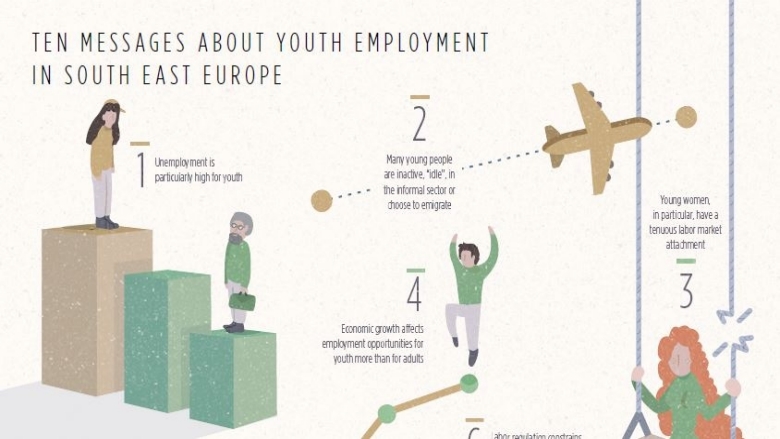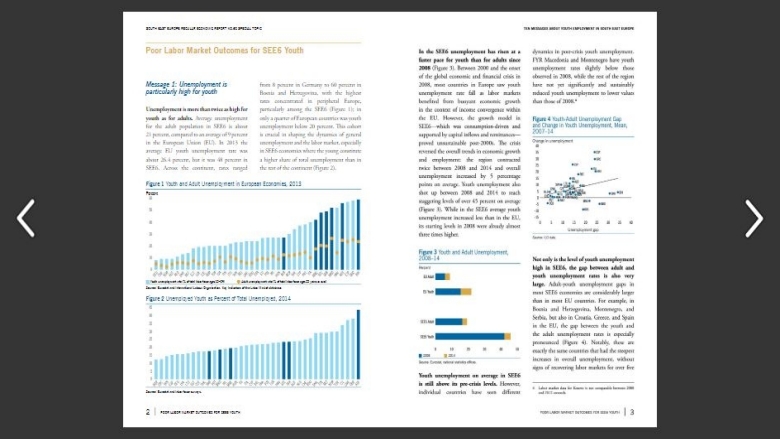1. Unemployment is still particularly high for youth
In South East Europe, unemployment is more than twice as high for youth as for adults. In 2013, the average youth unemployment rate in the European Union was about 26.4 percent, while in South East Europe it was 48 percent.
Youth unemployment in the SEE6 has risen at a faster pace for youth than for adults since 2008 and, on average, is still above its pre-crisis levels. However, individual countries have seen different dynamics in post-crisis youth unemployment. FYR Macedonia and Montenegro have youth unemployment rates slightly below those observed in 2008, while the rest of the region has not yet significantly and sustainably reduced youth unemployment to lower values than those of 2008.
2. Many young people are “idle” in the informal sector, or chose to emigrate
Many youth in SEE6 countries are not active in the labor market. Labor force participation averages 53 percent for adults, but about 34 percent for youth aged 15-24 years. In countries with a younger workforce, like Albania and Kosovo, youth account for a significantly higher share of the labor force than in the other countries in the region. Worryingly, the rates of young people not in employment, education or training (NEET) are high, eroding the quantity and quality of labor supply both currently and in the future.
While some youth remain outside the labor force because they face barriers to participating, the prospects for long-term unemployment can also push many discouraged young people to abandon the labor market and education altogether, or to migrate.
3. Young women have a tenuous attachment to the labor market

On average, there is a difference of about 20 percentage points in the activity rates of young men and women, widening significantly in countries like Kosovo and for youth from ethnic minorities. . These gaps result in economic costs that the region cannot afford, as they undermine its growth potential.
4. Economic growth affects employment opportunities for youth more than for adults
For both youth and adults in Europe, unemployment is responsive to GDP growth, but particularly so in South East Europe. There is solid evidence that rising youth unemployment is closely associated with economic contractions, and employment with expansions.
Youth are disproportionately affected by economic cycles compared to adults. Estimates of the average elasticity of youth and adult unemployment rates to GDP growth suggest that youth unemployment is “super-cyclical” and that for both youth and adult unemployment, the reaction is particularly large in South East Europe as compared to other European regions.
5. While youth lose significantly more jobs in economic downturns than adults do, it takes less economic growth to create jobs for youth than for adults in SEE6
There is ample evidence that youth unemployment reacts more strongly to negative economic shocks than to positive ones. Evidence suggests that the young segment of the workforce is disproportionately affected by large recession shocks both immediately and throughout the recovery.
For Europe, a decrease of 1 percentage point in GDP growth tends to raise the youth unemployment rate by 0.83 of a percentage point, but a positive growth shock of 1 percentage point decreases youth unemployment by only 0.54 of a percentage point; in contrast, adult unemployment goes up in a recession by just 0.34 of a percentage point, and goes down in an expansion by 0.21 of a percentage point.
6. Labor regulation constrains youth employment
There is ample evidence in the literature documenting that youth unemployment reacts more strongly to negative economic shocks than to positive ones. In the EU youth and adult unemployment rates tend to increase more during recessions than they are reduced during expansions. Reductions in both youth and adult unemployment are more dramatic in SEE6 than in the EU.
For example, for Europe, a positive growth shock of 1 percentage point decreases youth unemployment by only 0.54 of a percentage point, compared to a 1 percentage point decline in SEE6 youth unemployment rates.
7. Labor taxation is high for low-wage and part-time workers, groups where youth are over-represented

On average, labor taxation in South East Europe countries is less progressive than in the rest of Europe, which means that the tax wedge does not increase as sharply in these countries because individuals earn more. Therefore, beyond being a general disincentive to work if labor taxation is high, the structure of taxation can penalize youth in particular.
8. New labor market entrants are not equipped with the skills employers need
Most economies are moving to significantly high value-added and knowledge-intensive activities and services where “new economy” skills are particularly relevant. Youth are well-positioned to benefit from this structural change since many are still in, or can return to, education, and are arguably relatively more prepared to adapt to technological change than other workers. Moreover, despite increases in formal educational attainment, return to an additional year of education remain high – almost 10 percent.
However, many youth in SEE6 do not acquire the foundational skills that can help them succeed in a modern and dynamic labor market, with challenges in the quality and equity of the education and training systems.
9. Lack of access to finance, land and connections reduces opportunity for young people

Youth in the region have fewer employment prospects, including as entrepreneurs, if they have limited access to productive inputs. For example, the lack of finance and collateral among youth limits their entrepreneurial opportunities. Similarly, the lack of personal and professional connections, more salient among youth as new labor market entrants, accentuates their poor employment prospects. On average, about four out of five youth in South East Europe report that connections matter to get a public or private job; the figure is particularly high in Serbia.
10. Serious barriers prevent youth, particularly women, from entering the labor market
Attitudes, social norms and lack of access to child care services are among the more significant barriers facing youth – especially young women – in trying to enter the labor market. Attitudes and social norms have a major impact on markets and institutions: they shape individual and family decisions that directly and indirectly relate to the labor market.
Such attitudes and social norms in South East Europe tend to be most detrimental for young women, who are often confronted by resistance stemming from social norms about traditional roles. In addition, the lack of affordable child and elder care services can make it difficult for young women to combine work with studies and family responsibilities.
In Conclusion
Poor labor market outcomes in SEE6 have negative consequences not only for young people in the region, but for growth, poverty and social inclusion at all levels of society – regional, country and individual. Young people end up bearing the brunt of both structural and cyclical vulnerabilities embedded in the functioning of the region’s labor markets, and face more obstacles to get a job.
Because jobs are the main pathway to upward economic mobility, ensuring that youth have access to economic opportunities takes center stage in any agenda to raise living standards in the region. Importantly, policy measures to combat joblessness could often have a higher importance for youth than other age groups. Measures for promoting overall job creation should be complimented, and not replaced, by measures focused on youth.

